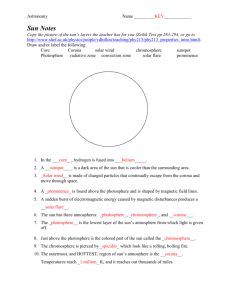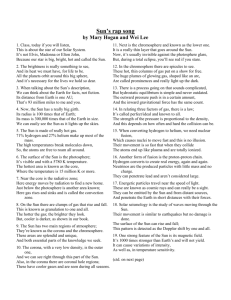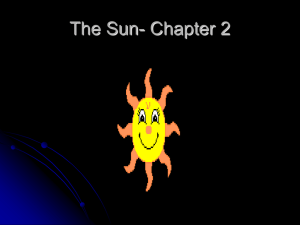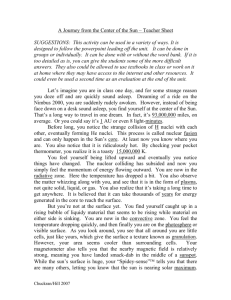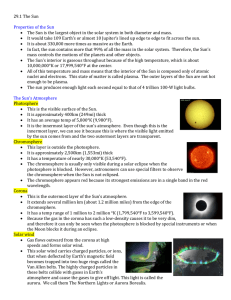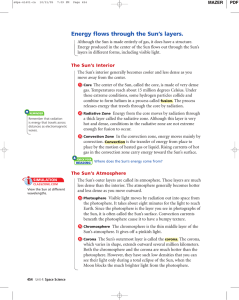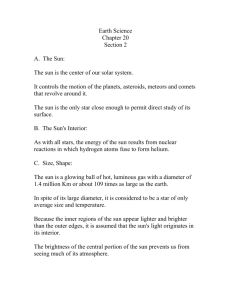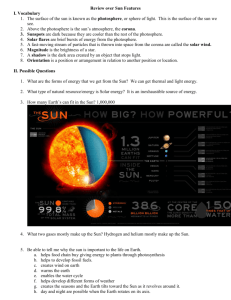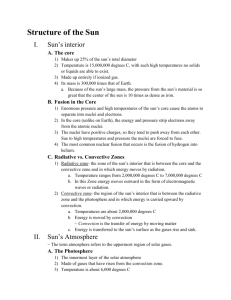Chapter 7 – The Sun
advertisement
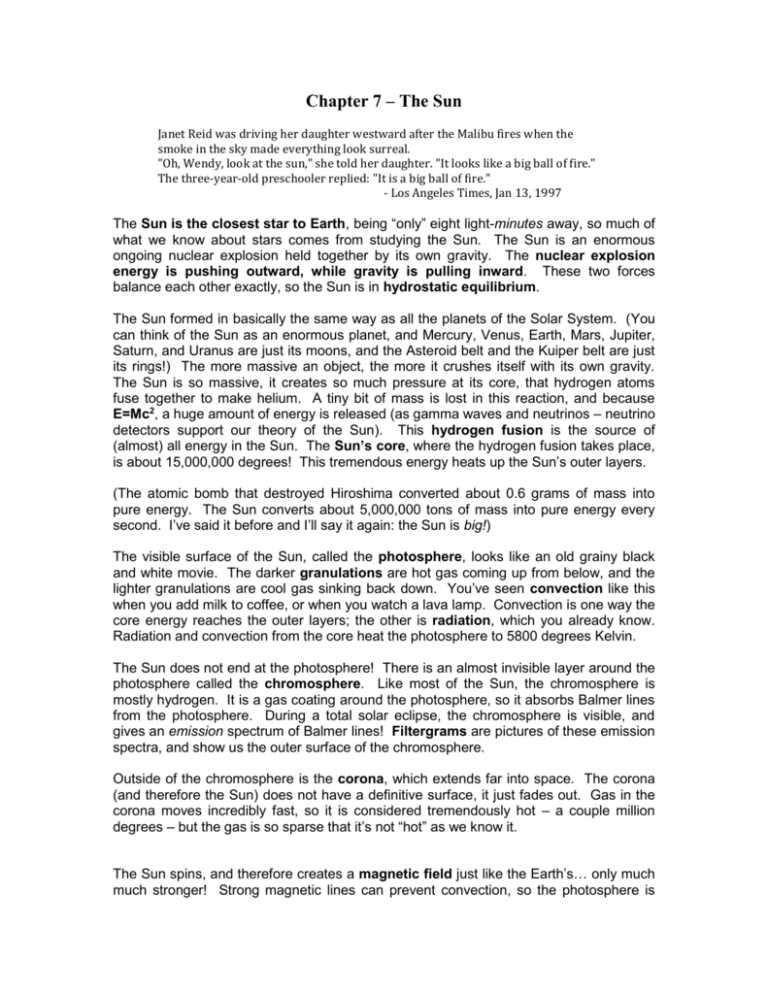
Chapter 7 – The Sun Janet Reid was driving her daughter westward after the Malibu fires when the smoke in the sky made everything look surreal. "Oh, Wendy, look at the sun," she told her daughter. "It looks like a big ball of fire." The three-year-old preschooler replied: "It is a big ball of fire." - Los Angeles Times, Jan 13, 1997 The Sun is the closest star to Earth, being “only” eight light-minutes away, so much of what we know about stars comes from studying the Sun. The Sun is an enormous ongoing nuclear explosion held together by its own gravity. The nuclear explosion energy is pushing outward, while gravity is pulling inward. These two forces balance each other exactly, so the Sun is in hydrostatic equilibrium. The Sun formed in basically the same way as all the planets of the Solar System. (You can think of the Sun as an enormous planet, and Mercury, Venus, Earth, Mars, Jupiter, Saturn, and Uranus are just its moons, and the Asteroid belt and the Kuiper belt are just its rings!) The more massive an object, the more it crushes itself with its own gravity. The Sun is so massive, it creates so much pressure at its core, that hydrogen atoms fuse together to make helium. A tiny bit of mass is lost in this reaction, and because E=Mc2, a huge amount of energy is released (as gamma waves and neutrinos – neutrino detectors support our theory of the Sun). This hydrogen fusion is the source of (almost) all energy in the Sun. The Sun’s core, where the hydrogen fusion takes place, is about 15,000,000 degrees! This tremendous energy heats up the Sun’s outer layers. (The atomic bomb that destroyed Hiroshima converted about 0.6 grams of mass into pure energy. The Sun converts about 5,000,000 tons of mass into pure energy every second. I’ve said it before and I’ll say it again: the Sun is big!) The visible surface of the Sun, called the photosphere, looks like an old grainy black and white movie. The darker granulations are hot gas coming up from below, and the lighter granulations are cool gas sinking back down. You’ve seen convection like this when you add milk to coffee, or when you watch a lava lamp. Convection is one way the core energy reaches the outer layers; the other is radiation, which you already know. Radiation and convection from the core heat the photosphere to 5800 degrees Kelvin. The Sun does not end at the photosphere! There is an almost invisible layer around the photosphere called the chromosphere. Like most of the Sun, the chromosphere is mostly hydrogen. It is a gas coating around the photosphere, so it absorbs Balmer lines from the photosphere. During a total solar eclipse, the chromosphere is visible, and gives an emission spectrum of Balmer lines! Filtergrams are pictures of these emission spectra, and show us the outer surface of the chromosphere. Outside of the chromosphere is the corona, which extends far into space. The corona (and therefore the Sun) does not have a definitive surface, it just fades out. Gas in the corona moves incredibly fast, so it is considered tremendously hot – a couple million degrees – but the gas is so sparse that it’s not “hot” as we know it. The Sun spins, and therefore creates a magnetic field just like the Earth’s… only much much stronger! Strong magnetic lines can prevent convection, so the photosphere is cooler near that magnetic line. This cooler area shows up as a sunspot. Sunspot density follows an 11-year cycle. (Really a 22-year cycle, but I’m being picky.) The Sun is not solid, and it does not rotate all together. The Sun’s equator rotates once in about 25 days, but the Sun’s poles rotate once in about 35 days. Because of this differential rotation, the magnetic field lines in the Sun get twisted and folded together. The magnetic field lines can suddenly “snap,” and create solar flares, which can knock out satellites. (Astronauts are alerted to large solar flares, and they take cover!) Lastly, this magnetic field is what “heats up” coronal gas, shooting electrons and protons into space at tremendous speeds. This is called the solar wind, and is what forms auroras on Earth and tails on comets, and protects Earth from cosmic radiation. (The solar wind has been decreasing over the last 20 years – nobody knows why.) We know a little about the Sun’s internal structure from helioseismology. The Sun vibrates a bit like a bell, and by using the Doppler Effect to carefully measure the vibrations, we can tease apart some details of the Sun’s insides. (You can imagine a bell filled with water and a bell filled with air would ring differently.) a poem I love, for your amusement Cosmic Gall By John Updike NEUTRINOS, they are very small they have no charge and have no mass and do not interact at all the Earth is just a silly ball to them, through which they simply pass like dustmaids down a drafty hall or photons through a sheet of glass they snub the most exquisite gas ignore the most substantial wall cold shoulder steel and sounding brass insult the stallion in his stall and scorning barriers of class infiltrate you and me like tall and painless guillotines, they fall down through our heads into the grass at night they enter at Nepal and pierce the lover and his lass from underneath the bed – you call it wonderful; I call it crass Homework Read chapter 7 (warning: I think section 7-2 does not explain nuclear fusion well.) Page 140 problems 2, 4, 7, 8, 9, 15
